Characteristics and Driving Forces of Non-Grain Production of Cultivated Land from the Perspective of Food Security
Abstract
:1. Introduction
2. Materials and Methods
2.1. Study Area
2.2. Data Source and Data Processing
2.3. Framework and Method
2.3.1. Meteorological Datasets
2.3.2. Method
Rate of Cultivated Land for Non-Grain Production
Spatial Autocorrelation Analysis
Construction of the Spatially Weighted Regression Model and Selection of Variables
3. Results
3.1. Non-Grain Characteristic
3.1.1. Characteristics of Cultivated Land for Non-Grain Production in Liyang
3.1.2. Characteristics of Cultivated Land for Non-Grain Production in Liyang
3.2. Spatial Autocorrelation
3.3. Influencing Factor
4. Discussion
5. Conclusions
Author Contributions
Funding
Conflicts of Interest
References
- Xue, X.D.; Gao, J.L. Analysis of Spatial Correlation Between Ecological Footprint and Food Security of Cultivated Land in Main Grain Production Areas. J. Ecol. Econ. 2021, 37, 93–99. [Google Scholar]
- Wu, S.C.; Yu, H.L.; Chu, Y.F. Limitations and Breakthroughs in Research on “Non-grain Production” of Cultivated Land under Scale Management of Agriculture. J. N. W. Ag. For. Univ. 2019, 19, 142–151. [Google Scholar]
- Zang, Y.; Liu, Y.; Yang, Y.; Woods, M.; Fois, F. Rural Decline or Restructuring? Implications for sustainability transitions in rural China. J. Land Use Pol. 2020, 94, 104531. [Google Scholar] [CrossRef]
- Su, Y.; Qian, K.; Lin, L.; Wang, K.; Guan, T.; Gan, M. Identifying the Driving Forces of Non-grain Production Expansion in Rural China and Its Implications for Policies on Cultivated Land Protection. Land Use Policy 2020, 92, 104435. [Google Scholar] [CrossRef]
- Kuang, Y.P.; Liu, Y. Comparison between Non-Agriculturization and Non-grain Production in Agricultural Land Transfer. J. Rur. Econ. 2018, 426, 1–6. [Google Scholar]
- Gao, X.Y.; Zhu, K.Y. The Potential Impact and Governance of Non-agriculturalization and Non-grain Production. J. Devel. Res. 2020, 210, 141–147. [Google Scholar]
- Grassini, P.; Eskridge, K.M.; Cassman, K.G. Distinguishing between Yield Advances and Yield Plateaus in Historical Crop Production Trends. J. Nat. Commun. 2013, 4, 2918. [Google Scholar] [CrossRef]
- Zhang, J.; He, C.; Chen, L.; Cao, S. Improving Food Security in China by Taking Advantage of Marginal and Degraded Lands. J. Clean. Prod. 2018, 171, 1020–1030. [Google Scholar] [CrossRef]
- Prishchepov, A.V.; Muller, D.; Dubinin, M.; Baumann, M.; Radeloff, V.C. Determinants of Agricultural Land Abandonment in Post-Soviet European Russia. Land Use Policy 2013, 30, 873–884. [Google Scholar] [CrossRef] [Green Version]
- Liu, Y.; Wu, C. Situation of land-water resources and analysis of sustainable food security in China. J. Nat. Resour. 2002, 17, 270–275. [Google Scholar]
- Li, W.; Feng, T.; Hao, J. The evolving concepts of land administration in China: Cultivated land protection perspective. Land Use Policy 2009, 26, 262–272. [Google Scholar] [CrossRef]
- Wang, D.; Jiang, H. Some thoughts on China’s food security based on the supply-side structural reform of agriculture. Economist 2017, 222, 78–87. [Google Scholar]
- Yi, X.Y.; Chen, Y.J. The Transfer of Cultivated Land and “Non-grain” Production: Based on the Survey Data among Farmers in Zhejiang and Hebei. J. China Rur. Surv. 2010, 96, 2–10, 21. [Google Scholar]
- Wang, H.; Qiu, F.; Ruan, X. Loss or Gain: A Spatial Regression Analysis of Switching Land Conversions between Agriculture and Natural Land. J. Agric. Ecosyst. Environ. 2016, 221, 222–234. [Google Scholar] [CrossRef]
- Su, B.; Li, Y.; Li, L.; Wang, Y. How Does Nonfarm Employment Stability Influence Farmers’ Farmland Transfer Decisions? Implications for China’s Land Use Policy. Land Use Policy 2018, 74, 66–72. [Google Scholar] [CrossRef]
- Wang, Y.; Chen, Y.J.; Yi, X.Y.; Xiao, B.L. Problems and Countermeasures Related to “Non-Grain” Production in the Transfer of Cultivated Land. J. China Agric. Resour. Reg. Plan. 2011, 32, 13–16. [Google Scholar]
- Liao, F.Z.; Liao, J.Y.; Yang, C. Problems and Countermeasures Related to Non-Grain Production in the Transfer of Cultivated Land. J. Tribune. Stud. 2015, 31, 37–40. [Google Scholar]
- Li, X.L. Preventing the “Non-Grain” Production in the Transfer of Cultivated Land. J. Grain Issues Res. 2012, 184, 41–43. [Google Scholar]
- Zhang, Z.Y.; Du, Z.X. Will Land Transfer Lead to “Non-Grain” Production? An Empirical Analysis Based on the Monitoring Data of 1740 Family Farms across China. J. Econ. Perspect. 2015, 9, 63–69. [Google Scholar]
- Cai, R.L.; Chen, W.M.; Zhu, X.C. Internal Causes of the Non-Grain Production in Cultivated Land Transfer and Countermeasures. J. Rur. Econ. 2015, 393, 44–49. [Google Scholar]
- Kong, X.B. Causes and Countermeasures to Non-Grain Production of Cultivated Land. J. China Land. 2020, 418, 17–19. [Google Scholar]
- Liu, C.Y.; Xiong, H.J. Research on Investment in Rural Areas in China: Literature Review and Discussion. J. West Forum. 2015, 25, 1–9. [Google Scholar]
- He, P.M.; Quan, L. Analysis of “Non-Grain” Production of Cultivated Land: From the Perspective of Food Security. J. Yangtze Univ. (Nat. Sci. Ed.) 2014, 11, 73–75. [Google Scholar]
- Hu, H.Z.; Wang, J.L.; Wang, Y.; Long, X.Y. Analysis of the Evolution and Influencing Factors of the Temporal and Spatial Patterns of Grain Production and Food Security in the Counties along the Yangtze River from 1990 to 2015. J. Resour. Environ. Yangtze Basin. 2019, 28, 359–367. [Google Scholar]
- Fu, Y.; Hou, K.C.; Dong, W.H.; Li, Y.Q. Discussion on “Non-Agriculturization” and “Non-Grain” Production Supervision of China’s Cultivated Land: Based on the Investigation of Ningxia Hui Autonomous Region. J. Nat. Resour. Econ. China 2021, 1–11. [Google Scholar] [CrossRef]
- Song, W.Q.; Yue, J.W. Influencing Factors and Countermeasures of “Non-Grain” Production of Cultivated Land: Take Yanggu County, Shandong Province as an Example. J. Ningxia Agric. For. Sci. Technol. 2020, 61, 17, 26–29. [Google Scholar]
- Chang, Y.Y.; Liu, J.N.; Zhang, Q.; Yu, H.C.; Bian, Z.F.; Chen, F. Differentiated Spatial Patterns of Non-Grain Production of Cultivated Land in Main Grain Production Areas and the Causes. J. Agric. Resour. Environ. 2021, 1–11. [Google Scholar] [CrossRef]
- Li, Y.Y.; Zhao, X.F. A PVAR-based Empirical Study on the Impact of Farmers’ Income Structure on the Non-Grain Production of Cultivated Land. J. Hubei Agric. Sci. 2020, 59, 210–214. [Google Scholar]
- Yang, Q.; Zhang, D. The influence of agricultural industrial policy on non-grain production of cultivated land: A case study of the “one village, one product” strategy implemented in Guanzhong Plain of China. Land Use Policy 2021, 108, 105579. [Google Scholar] [CrossRef]
- Su, Y.; Li, C.; Wang, K.E.L. Quantifying the spatiotemporal dynamics and multi-aspect performance of non-grain production during 2000–2015 at a fine scale. Ecol. Indic. 2019, 101, 410–419. [Google Scholar] [CrossRef]
- Chen, S.; Zeng, F.; Liu, H.E.L. Factors affecting farmers’ willingness to grow grain in key grain-producing areas: Based on the investigation of 475 rural households of Hunan Province. J. Hunan Agric. Univ. (Soc. Sci.) 2012, 85–88. [Google Scholar]
- Sun, Y.; Chang, Y.; Liu, J.E.L. Spatial Differentiation of Non-Grain Production on Cultivated Land and Its Driving Factors in Coastal China. Sustainability 2021, 13, 13064. [Google Scholar] [CrossRef]
- Zhao, X.; Zheng, Y.; Huang, X.; Kwan, M.P.; Zhao, Y. The Effect of Urbanization and Farmland Transfer on the Spatial Patterns of Non-grain Farmland in China. J. Sustain. 2017, 9, 1438. [Google Scholar] [CrossRef] [Green Version]
- Xu, Y.; Yu, L.; Zhao, F.R.; Cai, X.; Zhao, J.; Lu, H.; Gong, P. Tracking Annual Cropland Changes from 1984 to 2016 Using Time-Series Landsat Images with a Change-Detection and Post-Classification Approach: Experiments from Three Sites in Africa. J. Remote Sens. Environ. 2018, 218, 13–31. [Google Scholar] [CrossRef]
- Leroux, L.; Castets, M.; Baron, C.; Escorihuela, M.J.; Bégué, A.; Seen, D.L. Maize Yield Estimation in West Africa from Crop Process-Induced Combinations of Multi-Domain Remote Sensing Indices. J. Eur. J. Agron. 2019, 108, 11–26. [Google Scholar] [CrossRef]
- Liu, C.S.; He, H.G.; Zhang, S.S.; Zhou, L.Z. Discussion on the 3rd National Land Resource Survey of Guangzhou. J. Urban Geotech. Investig. Surv. 2020, 4, 135–138. [Google Scholar]
- Sui, Y.T.; Xu, L. On Policies of Land and Space Governance Based on Changes in the Techniques Used in the 3rd National Land Resource Survey. J. China Land. 2019, 12, 24–27. [Google Scholar]
- Guan, X.K.; Wang, X.L.; Zhao, Y.L. Research on Morphological Characteristics Recognition and Optimization of “Non-Grain” Production of Cultivated Land along the Yellow River. J. Trans. Chin. Soc. Agric. Mach. 2019, 52, 233–242. [Google Scholar]
- Anselin, L. Local Indicators of Spatial Association—LISA. J. Geogr. Anal. 1995, 27, 93–115. [Google Scholar] [CrossRef]
- Xu, J.H. Geographical Modeling Method; Science Press: Beijing, China, 2010. [Google Scholar]
- Fotheringham, A.S.; Brunsdon, C.; Charlton, M. Geographically Weighted Regression: The Analysis of Spatially Varying Relationships; John Wiley & Sons: Hoboken, NJ, USA, 2003. [Google Scholar]
- Han, J.; Rui, Y.; Yang, K.; Liu, W.; Ma, T. Quantitative Attribution of the Distribution of Key Towns in China Based on Geodetector and GWR. J. Prog. Geogr. 2020, 39, 1687–1697. [Google Scholar] [CrossRef]
- Wang, J.F.; Liao, Y.L.; Liu, X. A Tutorial on Spatial Data Analysis; Science Press: Beijing, China, 2010; p. 101. [Google Scholar]
- Su, Y. Research on the Spatiotemporal Evolution and Control of Non-Grain Production of Cultivated Land. Ph.D. Thesis, Zhejiang University, Hangzhou, China, 2020. [Google Scholar]
- Gatto, M.; Wollni, M.; Qaim, M. Oil Palm Boom and Land-Use Dynamics in Indonesia: The Role of Policies and Socioeconomic Factors. Land Use Policy 2015, 46, 292–303. [Google Scholar] [CrossRef] [Green Version]
- Feng, S.; Heerink, N.; Ruerd, R.; Qu, F. Land Rental Market, Off-Farm Employment and Agricultural Production in Southeast China: A plot-level case study. Chin. Econ. Rev. 2010, 21, 598–606. [Google Scholar] [CrossRef]
- Su, S.; Zhou, X.; Wan, C.; Li, Y.; Kong, W. Land Use Changes to Cash Crop Plantations: Crop Types, Multilevel Determinants and Policy Implications. Land Use Policy 2016, 50, 379–389. [Google Scholar] [CrossRef]
- Tematio, P.; Olson, K.R. Impacts of industrialized agriculture on land in Bafou, Cameroon. J. Soil. W. Conser. 1997, 52, 404–405. [Google Scholar]
- Su, S.; Xiao, R.; Li, D. Impacts of Transportation Routes on Landscape Diversity: A Comparison of Different Route Types and Their Combined Effects. Environ. Manag. 2014, 53, 636–647. [Google Scholar] [CrossRef]
- Ding, Z.W.; Liu, Y.Y.; Wu, X.N.; Wei, Y.X.; Qiao, X.F.; Zhang, H.P.; Zhang, G.S. Differentiated Spatial Pattern and Influence of China’s Township Economy: Based on the Per Capita Net Income of Farmers in 755 Towns. J. Econ. Geogr. 2020, 40, 18–28, 38. [Google Scholar]
- Liu, Z.W. Akaike Information Criterion and Its Significance. J. Math. Pract. Theory. 1980, 3, 64–72. [Google Scholar]
- Fortheringham, S.; Brunsdon, C.H.; Charlton, M. Quantitative Geography; SAGE Publications: London, UK, 2000. [Google Scholar]
- Zhu, D.L.; Gao, Y. Analysis of the Farmers’ Reluctance to Grow Grain and the Degradation of Grain Growing Industry: Based on the Survey of 486 Households in 32 Villages in Fujian, Jiangxi, Ezhe and Zhejiang. J. Jimei Univ. (Philos. Soc. Sci. Ed.) 2013, 16, 41–48. [Google Scholar]
- Simelton, E. Food Self-Sufficiency and Natural Hazards in China. Food Secur. 2011, 3, 35–52. [Google Scholar] [CrossRef]
- Zhang, L.; Song, B.; Chen, B. Emergy-Based Analysis of Four Farming Systems: Insight into Agricultural Diversification in Rural China. J. Clean. Prod. 2012, 28, 33–44. [Google Scholar] [CrossRef]
- Gellrich, M.; Baur, P.; Koch, B.; Zimmermann, N.E. Agricultural Land Abandonment and Natural Forest Re-Growth in the Swiss Mountains: A Spatially Explicit Economic Analysis. Agric. Ecosyst. Environ. 2007, 118, 93–108. [Google Scholar] [CrossRef]
- Anselin, L. Under The Hood: Issues in the Specification and Interpretation of Spatial Regression Models. Agric. Econ. 2002, 27, 247–267. [Google Scholar] [CrossRef]
- Guo, Z. The Performance, Driving Mechanism and Governance of Functional Loss of Cultivated Land. J. Jishou Univ. (Soc. Sci. Ed.) 2020, 41, 56–63. [Google Scholar]
- Yang, J.; Wang, H.; Jin, S.; Chen, K.; Riedinger, J.; Peng, C. Migration, Local Off-Farm Employment, and Agricultural Production Efficiency: Evidence from China. J. Prod. Anal. 2016, 45, 247–259. [Google Scholar] [CrossRef] [Green Version]
- Dong, Z.; Wang, D. Technological Innovation, Production Mode Reform and Agricultural Modernization. Expand. Horiz. 2019, 216, 34–40. [Google Scholar]
- Wang, H.; Lu, J. Food Security and Sustainable Economic Development under Environmental Constraints. Resour. Sci. 2014, 36, 2149–2156. [Google Scholar]
- Fare, R.; Grosskopf, S.; Pasurka, C. Environmental productionfunctions and environmental directional distance functions. Energy 2007, 32, 1055–1066. [Google Scholar] [CrossRef]
- Huang, J.; Wang, X.; Rozelle, S. The subsidization of farming households in China’s agriculture. Food Policy 2013, 41, 124–132. [Google Scholar] [CrossRef]
- Jiang, P. Constructing Food Security Pattern in the New Era from the Perspective of Integrated Development of Urban and Rural Areas--Also on the Three Constraints and Challenges of China’s Food Production. Beijing Plan. Rev. 2021, 1, 164–169. [Google Scholar]
- Hansen, M.; Li, H.; Svarverud, R. Ecological civilization: Interpreting the Chinese past, projecting the global future. Glob. Environ. Chang. 2018, 53, 195–203. [Google Scholar] [CrossRef]
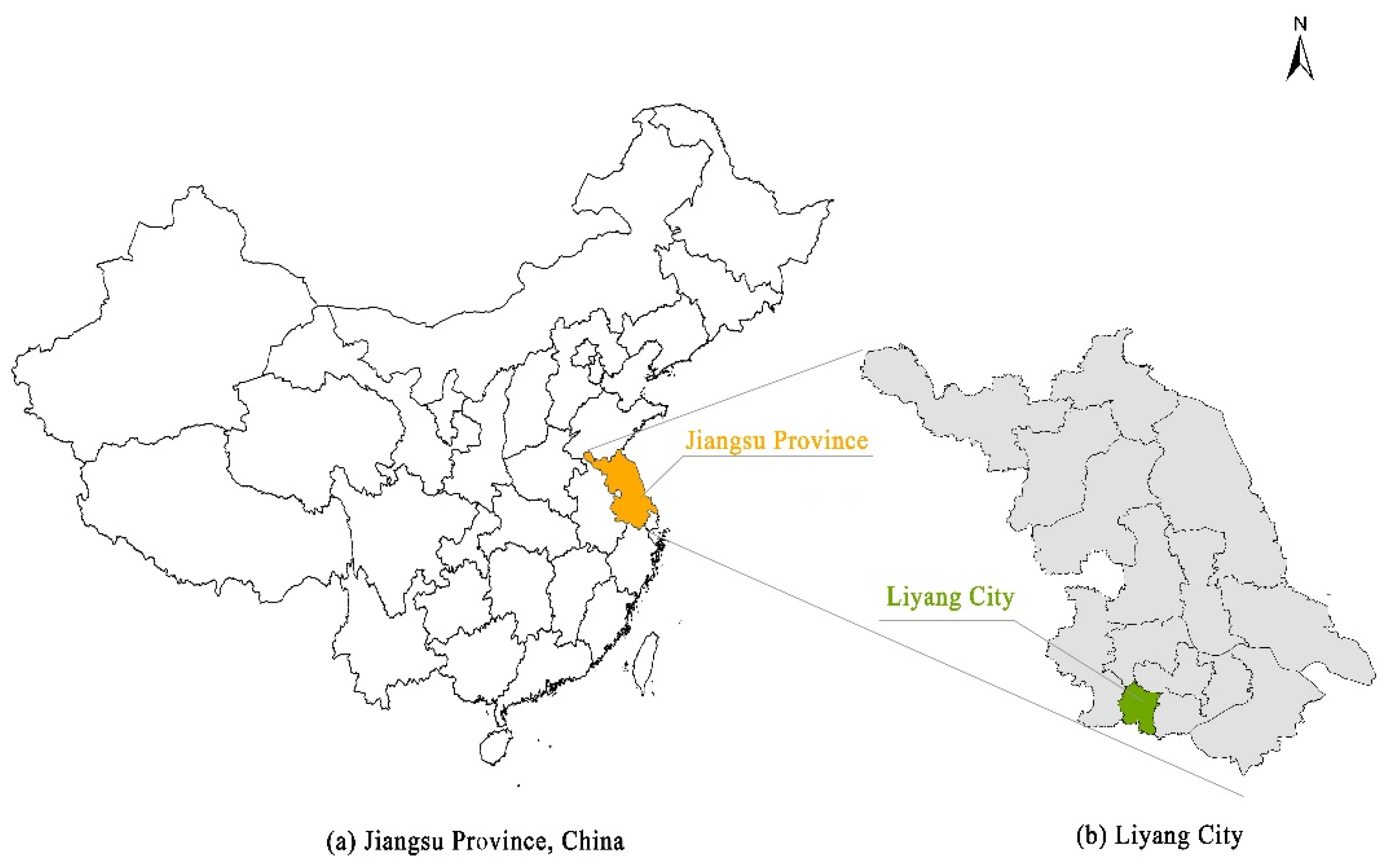
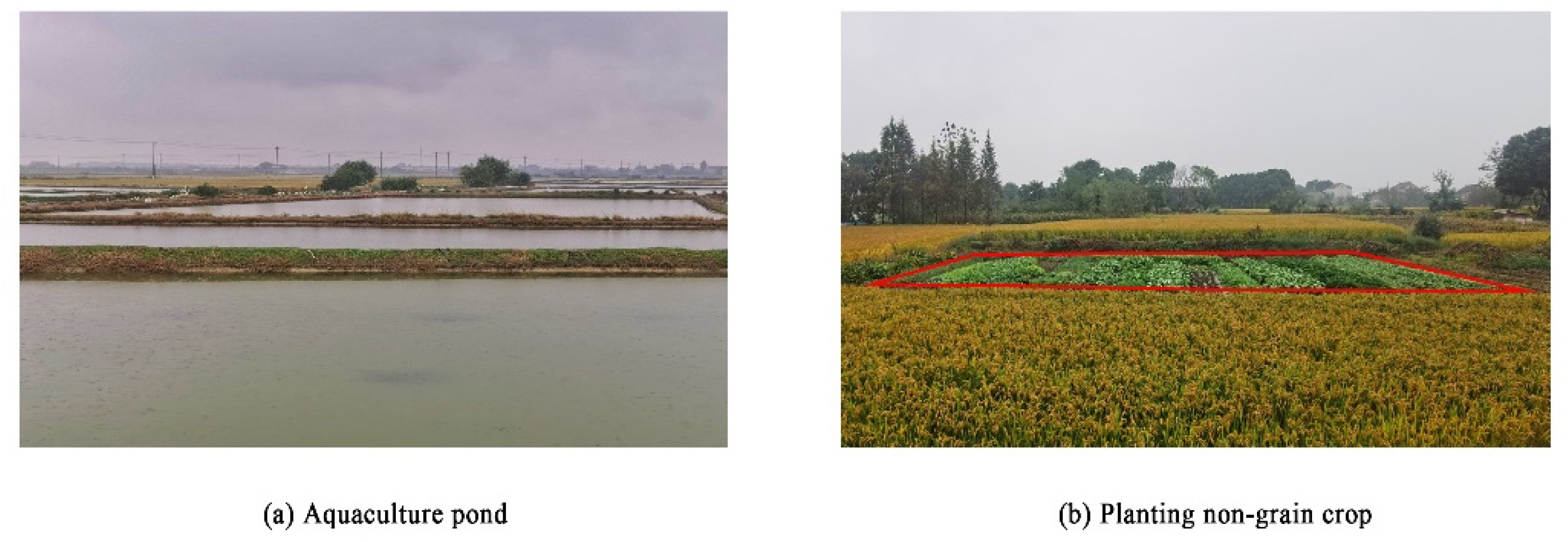

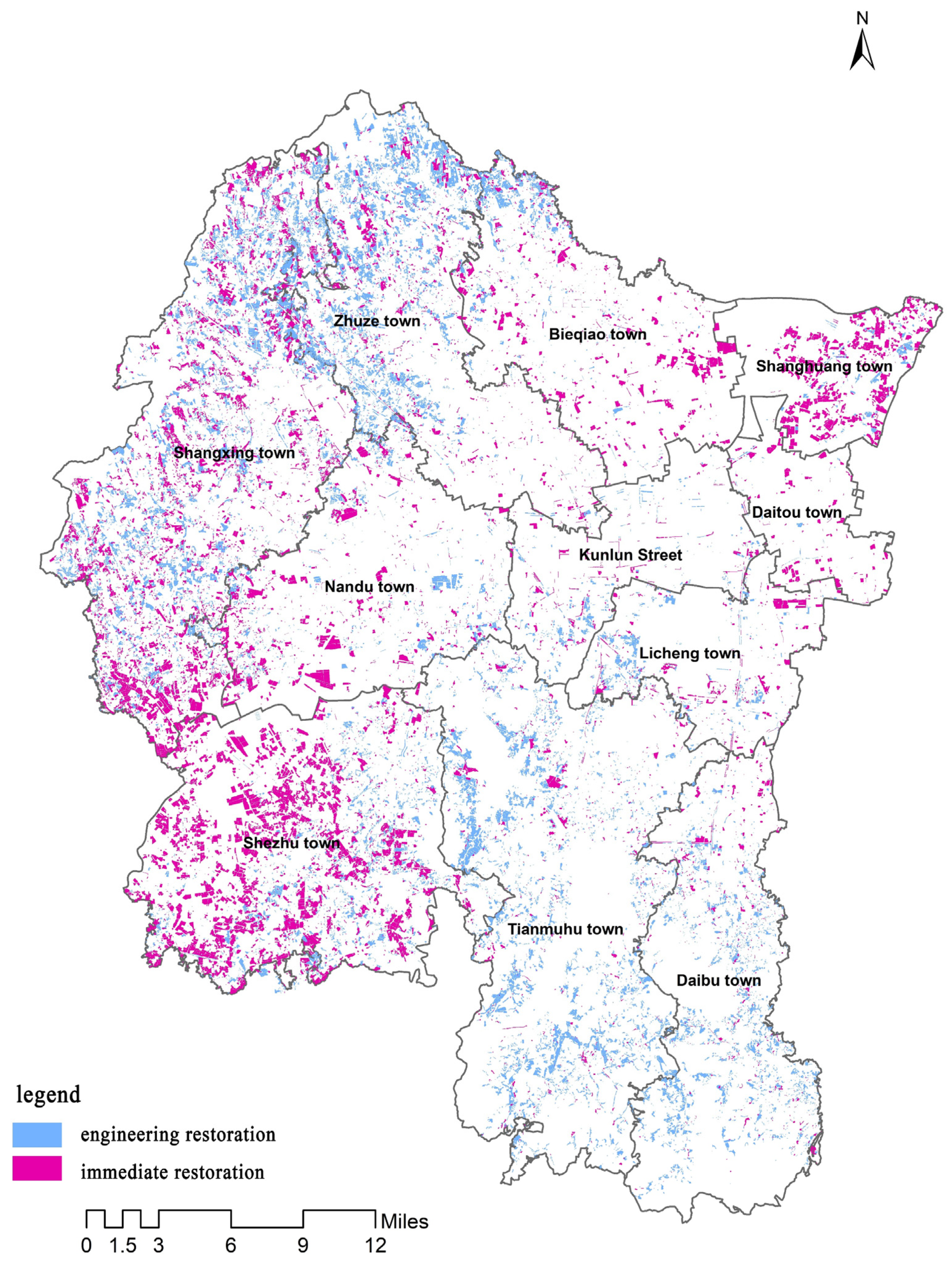
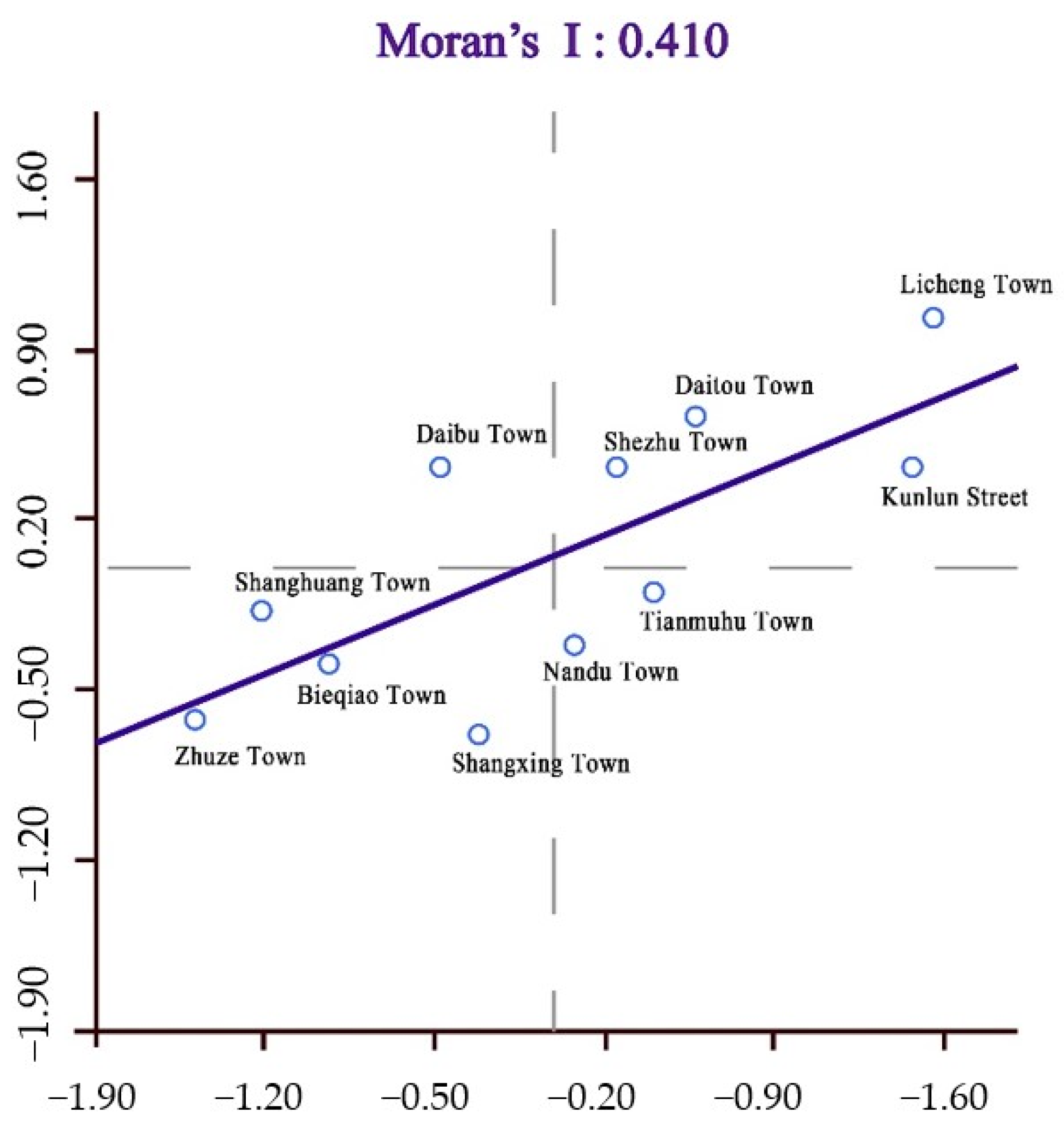
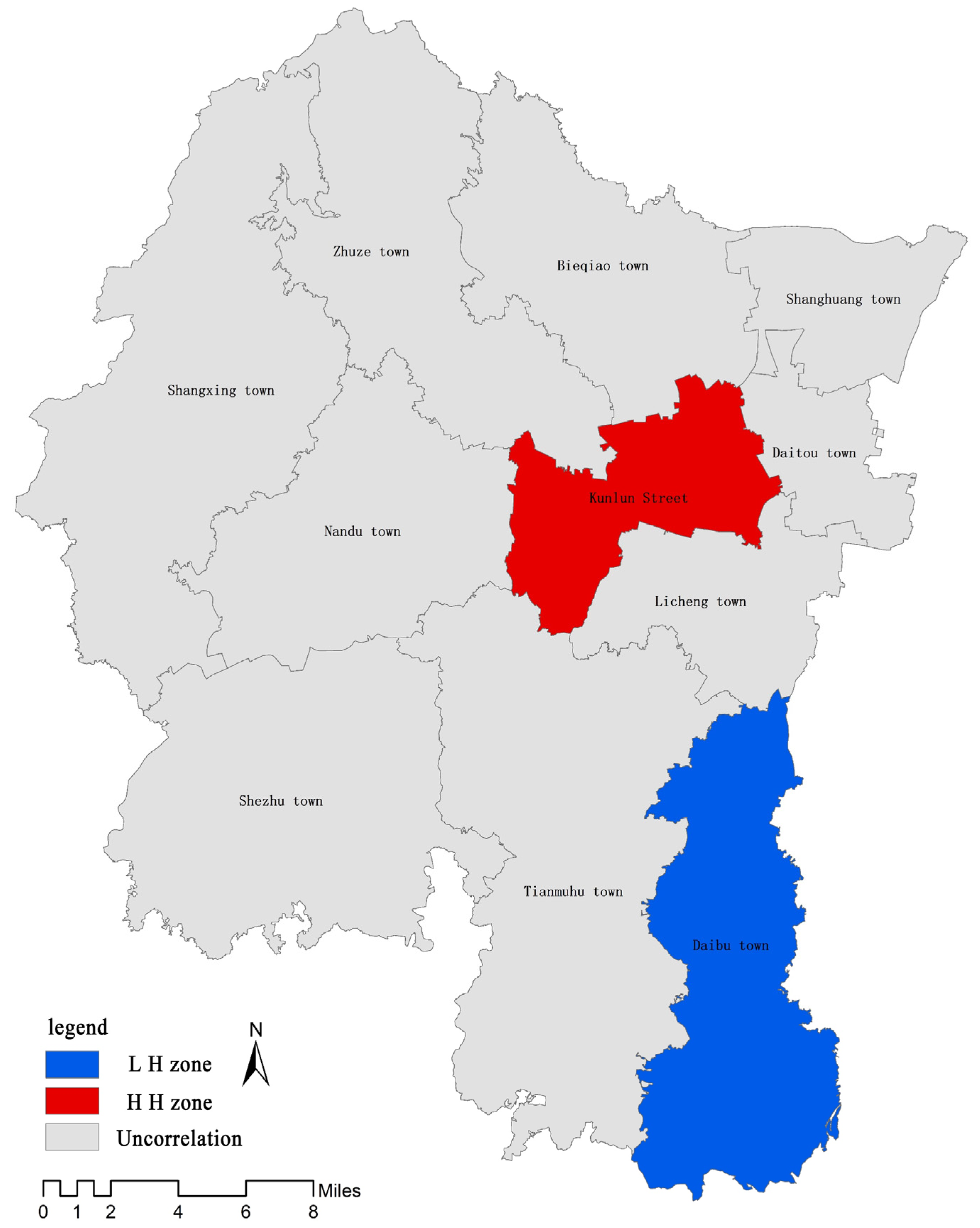
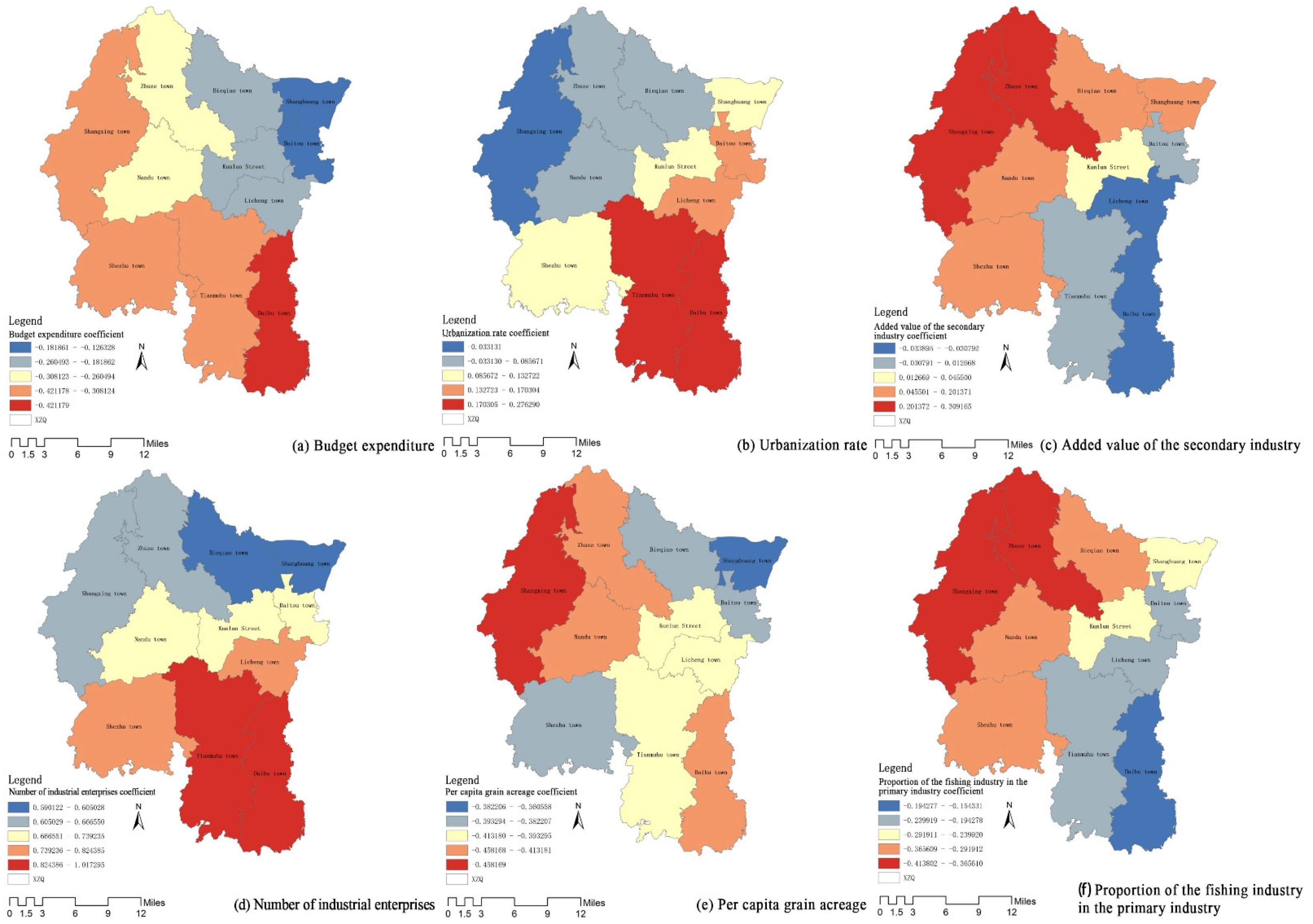
| Town | Cultivated Land Area/Hectare in 2019 | Proportion in the City’s Total/% |
|---|---|---|
| Kunlun Street | 2191.80 | 4.89 |
| Licheng Town | 1822.62 | 4.07 |
| Daitou Town | 1800.52 | 4.02 |
| Shanghuang Town | 770.50 | 1.72 |
| Daibu Town | 2633.01 | 5.87 |
| Tianmuhu Town | 3083.74 | 6.88 |
| Bieqiao Town | 5838.10 | 13.02 |
| Shangxing Town | 8181.36 | 18.25 |
| Zhuze Town | 5560.24 | 12.40 |
| Nandu Town | 6836.84 | 15.25 |
| Shezhu Town | 6108.17 | 13.63 |
| Total | 44,826.91 | 100 |
| Criterion | Independent Variable | Correlation Coefficient | p Value |
|---|---|---|---|
| Sector factors | Budget expenditure | 0.891 ** | 0.000 |
| Added value of the primary industry | −0.198 | 0.28 | |
| Added value of the secondary industry | 0.756 ** | 0.004 | |
| Agricultural factors | Per capita grain acreage | −0.585 * | 0.029 |
| Proportion of the fishing industry in the primary industry | −0.523 * | 0.05 | |
| Proportion of labor force in the primary industry | 0.191 | 0.286 | |
| Industrial factors | Urbanization rate | 0.623 * | 0.02 |
| Number of industrial enterprises | 0.886 ** | 0.000 | |
| Geographic factors | Road density | 0.486 | 0.065 |
| Average altitude | 0.227 | 0.503 |
| Independent Variable | Upper Quartile | Median | Lower Quartile | Maximum | Minimum | Mean | SD |
|---|---|---|---|---|---|---|---|
| Budget expenditure | −0.3167 | −0.2605 | −0.1831 | −0.1263 | −0.4212 | −0.2487 | 0.0876 |
| Added value of the secondary industry | 0.0016 | 0.1213 | 0.1824 | 0.3092 | −0.0339 | 0.1051 | 0.1116 |
| Per capita grain acreage | −0.4154 | −0.3949 | −0.3876 | −0.3606 | −0.4582 | −0.4014 | 0.0246 |
| Proportion of the fishing industry in the primary industry | −0.3171 | −0.2486 | −0.2004 | −0.1543 | −0.4138 | −0.2676 | 0.0768 |
| Urbanization rate | 0.0736 | 0.1302 | 0.1637 | 0.2763 | −0.0331 | 0.1241 | 0.0815 |
| Number of industrial enterprises | 0.6506 | 0.7315 | 0.8175 | 1.0173 | 0.5901 | 0.7511 | 0.1280 |
Publisher’s Note: MDPI stays neutral with regard to jurisdictional claims in published maps and institutional affiliations. |
© 2021 by the authors. Licensee MDPI, Basel, Switzerland. This article is an open access article distributed under the terms and conditions of the Creative Commons Attribution (CC BY) license (https://creativecommons.org/licenses/by/4.0/).
Share and Cite
Li, Y.; Zhao, B.; Huang, A.; Xiong, B.; Song, C. Characteristics and Driving Forces of Non-Grain Production of Cultivated Land from the Perspective of Food Security. Sustainability 2021, 13, 14047. https://doi.org/10.3390/su132414047
Li Y, Zhao B, Huang A, Xiong B, Song C. Characteristics and Driving Forces of Non-Grain Production of Cultivated Land from the Perspective of Food Security. Sustainability. 2021; 13(24):14047. https://doi.org/10.3390/su132414047
Chicago/Turabian StyleLi, Yongfu, Bochuan Zhao, An Huang, Binyu Xiong, and Canfeng Song. 2021. "Characteristics and Driving Forces of Non-Grain Production of Cultivated Land from the Perspective of Food Security" Sustainability 13, no. 24: 14047. https://doi.org/10.3390/su132414047
APA StyleLi, Y., Zhao, B., Huang, A., Xiong, B., & Song, C. (2021). Characteristics and Driving Forces of Non-Grain Production of Cultivated Land from the Perspective of Food Security. Sustainability, 13(24), 14047. https://doi.org/10.3390/su132414047





